Plus Two Zoology Notes Chapter 1 Human Reproduction is part of Plus Two Zoology Notes. Here we have given Plus Two Zoology Notes Chapter 1 Human Reproduction.
| Board | SCERT, Kerala |
| Text Book | NCERT Based |
| Class | Plus Two |
| Subject | Zoology Notes |
| Chapter | Chapter 1 |
| Chapter Name | Human Reproduction |
| Category | Plus Two Kerala |
Kerala Plus Two Zoology Notes Chapter 1 Human Reproduction
The Male Reproductive System
It consists of

Diagrammatic view of male reproductive system:

The testes are seen in a pouch called scrotum. It helps in maintaining the low temperature of the testes (2 – 2.5° C).
Each testis has about 250 compartments called testicular lobules. Each lobule contains one to three highly coiled seminiferous tubules in which sperms are produced.
Seminiferous tubule:
It consists of

The male germ cells produce sperm Sertoli cells provide nutrition to the germ cells. Leydig cells secrete testicular hormones called androgens:
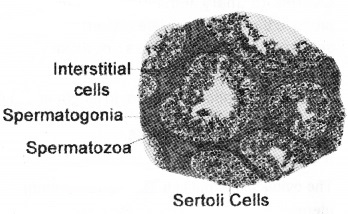
Male sex accessory ducts:
It consists of
The seminiferous tubules of the testis open into rete testis

The vasa efferentia open into epididymis. The epididymis leads to vas deferens. It receives a duct from seminal vesicle and opens into urethra as the ejaculatory duct.
The urethra extends through the penis to its external opening called urethral meatus. The penis is the male external genitalia made up of special tissue that helps in erection of the penis to facilitate insemination.
The enlarged end of penis called the glans penis is covered by a loose fold of skin called foreskin.
Male accessory glands:
It consists of

Secretions of these glands constitute the seminal plasma (fructose, calcium and certain enzymes). The secretions of bulbourethral glands helps in the lubrication of the penis.
The Female Reproductive System
It consists of
| 1. A pair of ovaries |
| 2. A pair of oviducts |
| 3. Uterus |
| 4. Cervix |
| 5. Vagina |
| 6. External genitalia |
| 7. Mammary glands |
Digrammatic sectional view of female reproductive system:
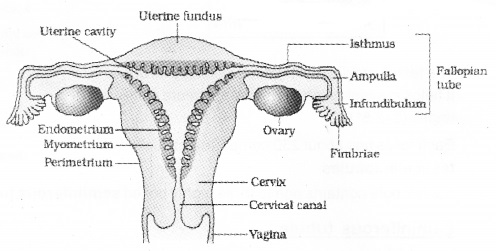
Ovaries (primary female sex organ) produce the female gamete (ovum) and several steroid hormones (ovarian hormones).
Each ovary is about 2 to 4 cm in length and is connected to the pelvic wall and uterus by ligaments.
Female accessory ducts:
It consists of
The oviducts (fallopian tubes – 10 – 12 cm long)
uterus
vagina
Its parts
| The funnel-shaped infundibulum. finger-like projections called fimbriae The wider part of the oviduct called ampulla. The last part of the oviduct isthmus joins the uterus. |
The uterus opens into vagina through a narrow cervix. The cavity of the cervix is called cervical canal. The wall of the uterus has three layers of tissue.
- External perimetrium
- Middle myometrium and
- Inner endometrium
The endometrium undergoes cyclical changes during menstrual cycle while the myometrium exhibits strong contraction during delivery of the baby.
Female external genitalia:
It consists of
- Mons pubis (cushion of fatty tissue covered by skin and pubic hair)
- Labia majora (fleshy folds of tissue extend down from the mons pubis and surround the vaginal opening)
- Labia minora (paired folds of tissue under the labia majora)
- Hymen (opening of the vagina is often covered partially by a membrane)
- Clitoris (a tiny finger-like structure which lies above the urethral opening)
The hymen is torn during the first coitus (intercourse). Mammary glands (paired structures (breasts)). 15-20 mammary lobes containing clusters of cells called alveoli. The cells of alveoli secrete milk, which is stored in the cavities of alveoli.
| Alveoli -mammary duct- mammary ampulla- lactiferous duct through which milk is sucked out. |
Gametogenesis
Spermatogenesis:
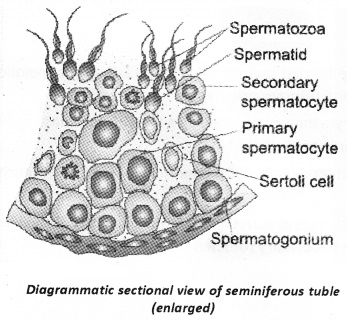
Some of the spermatogonia( diploid) called primary spermatocytes undergo meiosis. First meiotic division (reduction division) leading to formation of two equal haploid cells called secondary spermatocytes, second meiotic division produce four equal haploid spermatids.
The spermatids are transformed into spermatozoa (sperms) by the process called spermiogenesis.
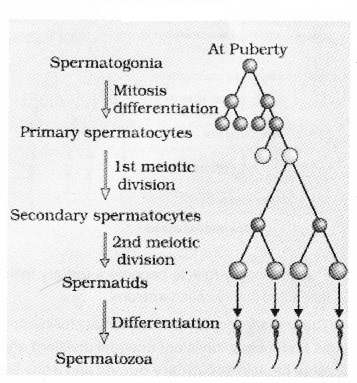
After spermiogenesis, sperm heads become embedded in the Sertoli cells and are finally released from the seminiferous tubules by the process called spermiation.
The GnRH stimulates the secretion of two gonadotropins
- Luteinising hormone (LH)
- Follicle-stimulating hormone (FSH).
LH acts at the Leydig cells and secretes androgens that stimulate the process of spermatogenesis. FSH acts on the Sertoli cells and stimulates the secretion of some factors which help in the process of spermiogenesis.
Sperm:
Structure of sperm
It consists of
| 1. Head |
| 2. Neck |
| 3. A middle piece and |
| 4. A tail |
The sperm head is covered by a cap-like structure, acrosome (contains the enzymes that help fertilisation of the ovum).
The middle piece possesses numerous mitochondria, which produce energy for sperm motility.
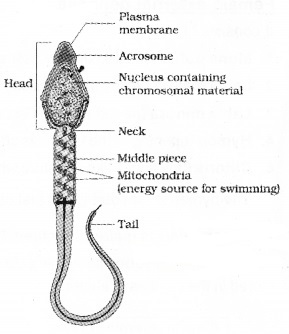
The human male ejaculates about 200 to 300 million sperms during a coitus of which 60 per cent sperms have normal shape and 40 per cent of show vigorous motility.
The Secretions of epididymis, vas deferens, seminal vesicle and prostate are essential for maturation and motility of sperms.
The seminal plasma with the sperms constitute the semen.
Oogenesis:
Oogonia are formed in embryonic stage udergores meiotic division to form primary oocytes. Primary oocyte then surrounded by a layer of granulosa cells and forms primary follicle.
During puberty 60,000-80,000 primary follicles are found in each ovary. The primary follicle is surrounded by more layers of granulosa and become secondary follicles.
Spermatogenesis

The secondary follicle become a tertiary follicle with fluid filled cavity called antrum. The primary oocyte within the tertiary follicle completes its first meiotic division( unequal division) and forms large haploid secondary oocyte and a tiny first polar body.
The tertiary follicle changes into the mature follicle or Graafian follicle.
Diagrammatic section view of ovary:
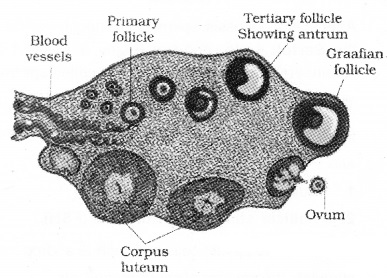
The secondary oocyte then forms a new membrane called zona pellucida surrounding it.
| The Graafian follicle ruptures to release the secondary oocyte (ovum) from the ovary by the process called ovulation. |
Menstrual Cycle
Diagrammatic representation of various events during a menstrual cycle:
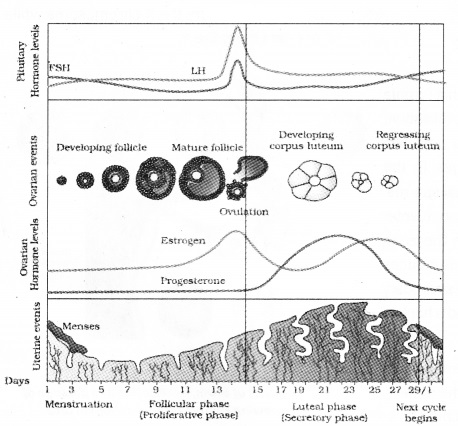
1. The menstrual phase:
First menstruation begins at puberty and is called menarche. In human females it is repeated at interval of about 28/29 days.
The menstrual flow is due to the breakdown of endometrial lining of the uterus and its blood vessels which forms liquid that comes out through vagina.
Menstruation only occurs if the released ovum is not fertilised. Lack of menstruation may be indicative of pregnancy.
2. The follicular phase:
During this phase, the primary follicles grows into mature Graafian follicle and endometrium of uterus regenerates through proliferation.
3. The ovulatory phase:
Both LH and FSH attain a peak level in the middle of cycle (about 14th day).
4. The luteal phase:
Remaining parts of the Graafian follicle transform into corpus luteum. The corpus luteum secretes large amounts of progesterone which helps in the maintenance of the endometrium (implantation of the fertilized ovum).
In the absence of fertilisation, the corpus luteum degenerates. This causes disintegration of the endometrium leading to menstruation.In human beings, menstrual cycles ceases around 50 years of age termed as menopause.
Fertilisation And Implantation
During copulation (coitus) semen is released by the penis into the vagina (insemination).
| The motile sperms reach the junction of the isthmus and ampulla (ampullary-isthmic junction) of the fallopian tube and fuses with the released ovum (fertilization) it results a diploid zygote. |
Ovum surrounded by few sperms:
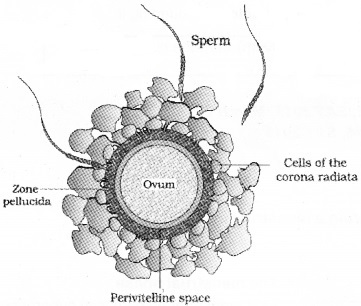
During fertilisation, a sperm comes in contact with the zona pellucida layer of the ovum and induces changes in the membrane that block the entry of additional sperms.
The secretions of the acrosome help the sperm enter into the cytoplasm of the ovum through the zona pellucida and the plasma membrane. This induces the completion of the meiotic division of the secondary oocyte and forms a second polar body and a haploid ovum (ootid).
All the haploid gametes produced by the female (ova) have sex chromosome X whereas in the male gametes (sperms) the sex chromosome could be either X or Y, hence, 50 percent of sperms carry the X chromosome while the other 50 percent carry the Y.
The zygote carrying XX would develop into a female baby and XY would form a male. During fertilisation, a sperm comes in contact with the zona pellucida layer of the ovum and induces changes in the membrane that block the entry of additional sperms.
Transport of ovum, fertilisation and passage of growing embryo through the fallopian tube:
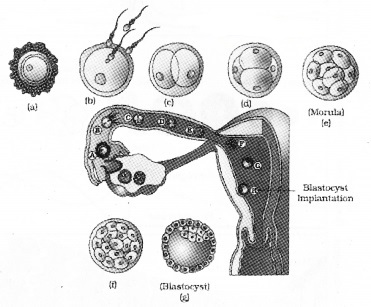
The secretions of the acrosome help the sperm enter into the cytoplasm of the ovum through the zona pellucida and the plasma membrane. This induces the completion of the meiotic division of the secondary oocyte and forms a second polar body and a haploid ovum (ootid).
All the haploid gametes produced by the female (ova) have sex chromosome X whereas in the male gametes (sperms) the sex chromosome could be either X or Y, hence, 50 percent of sperms carry the X chromosome while the other 50 percent carry the Y.
The zygote carrying XX would develop into a female baby and XY would form a male. The mitotic division of zygote is called cleavage and forms 2, 4, 8, 16 daughter cells called blastomeres. The embryo with 8 to 16 blastomeres is called a morula. The morula continues to divide and transforms into blastocyst then it moves into the uterus.
The outer layer of the blastocyst is called trophoblast and an inner group of cells called inner cell mass. The trophoblast layer gets attached to the endometrium and the inner cell mass gets differentiated as the embryo.
Later the blastocyst becomes embedded in the endometrium of the uterus. This is called implantation and it leads to pregnancy.
The milk produced during the initial few days of lactation is called colostrum which contains several antibodies that provide resistance for new-born babies.
We hope the Plus Two Zoology Notes Chapter 1 Human Reproduction helps you. If you have any query regarding Plus Two Zoology Notes Chapter 1 Human Reproduction, drop a comment below and we will get back to you at the earliest.
